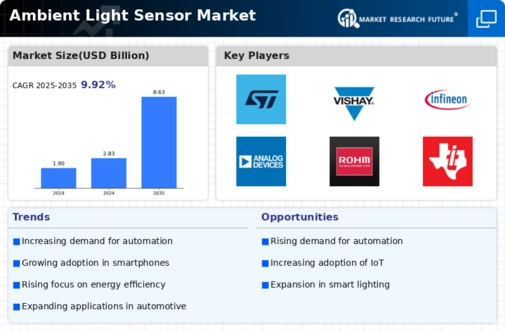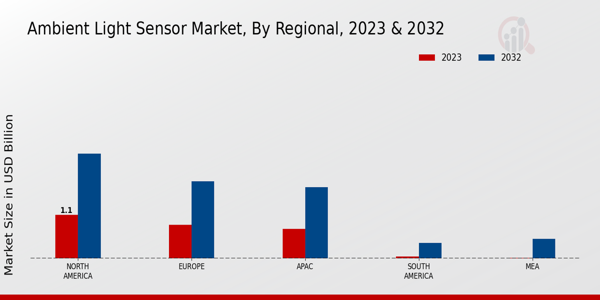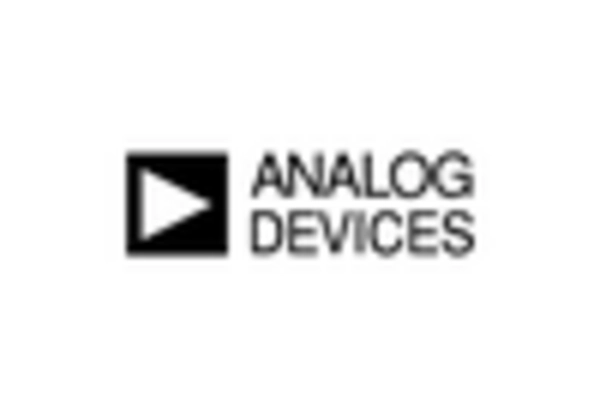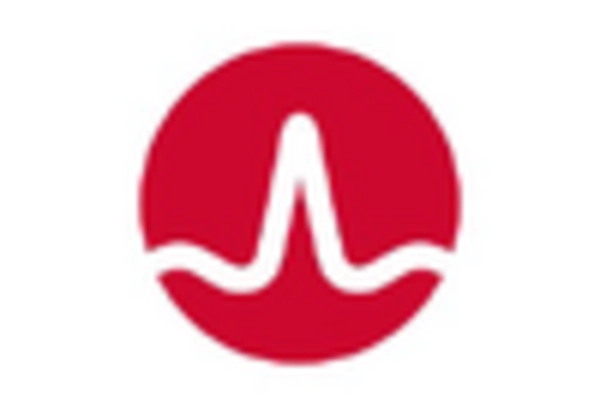-
EXECUTIVE SUMMARY
-
Market Overview
-
Key Findings
-
Market Segmentation
-
Competitive Landscape
-
Challenges and Opportunities
-
Future Outlook
-
MARKET INTRODUCTION
-
Definition
-
Scope of the study
- Research Objective
- Assumption
- Limitations
-
RESEARCH METHODOLOGY
-
Overview
-
Data Mining
-
Secondary Research
-
Primary Research
- Primary Interviews and Information Gathering Process
- Breakdown of Primary Respondents
-
Forecasting Model
-
Market Size Estimation
- Bottom-Up Approach
- Top-Down Approach
-
Data Triangulation
-
Validation
-
MARKET DYNAMICS
-
Overview
-
Drivers
-
Restraints
-
Opportunities
-
MARKET FACTOR ANALYSIS
-
Value chain Analysis
-
Porter''s Five Forces Analysis
- Bargaining Power of Suppliers
- Bargaining Power of Buyers
- Threat of New Entrants
- Threat of Substitutes
- Intensity of Rivalry
-
COVID-19 Impact Analysis
- Market Impact Analysis
- Regional Impact
- Opportunity and Threat Analysis
-
AMBIENT LIGHT SENSOR MARKET, BY APPLICATION (USD BILLION)
-
Consumer Electronics
-
Automotive
-
Industrial
-
AMBIENT LIGHT SENSOR MARKET, BY SENSOR TYPE (USD BILLION)
-
Photodiode
-
Photoresistor
-
Phototransistor
-
AMBIENT LIGHT SENSOR MARKET, BY TECHNOLOGY (USD BILLION)
-
Analog
-
Digital
-
AMBIENT LIGHT SENSOR MARKET, BY END USE (USD BILLION)
-
Residential
-
Commercial
-
Industrial
-
AMBIENT LIGHT SENSOR MARKET, BY REGIONAL (USD BILLION)
-
North America
- US
- Canada
-
Europe
- Germany
- UK
- France
- Russia
- Italy
- Spain
- Rest of Europe
-
APAC
- China
- India
- Japan
- South Korea
- Malaysia
- Thailand
- Indonesia
- Rest of APAC
-
South America
- Brazil
- Mexico
- Argentina
- Rest of South America
-
MEA
- GCC Countries
- South Africa
- Rest of MEA
-
COMPETITIVE LANDSCAPE
-
Overview
-
Competitive Analysis
-
Market share Analysis
-
Major Growth Strategy in the Ambient Light Sensor Market
-
Competitive Benchmarking
-
Leading Players in Terms of Number of Developments in the Ambient Light Sensor Market
-
Key developments and growth strategies
- New Product Launch/Service Deployment
- Merger & Acquisitions
- Joint Ventures
-
Major Players Financial Matrix
- Sales and Operating Income
- Major Players R&D Expenditure. 2023
-
COMPANY PROFILES
-
AMS
- Financial Overview
- Products Offered
- Key Developments
- SWOT Analysis
- Key Strategies
-
STMicroelectronics
- Financial Overview
- Products Offered
- Key Developments
- SWOT Analysis
- Key Strategies
-
Vishay Intertechnology
- Financial Overview
- Products Offered
- Key Developments
- SWOT Analysis
- Key Strategies
-
Infineon Technologies
- Financial Overview
- Products Offered
- Key Developments
- SWOT Analysis
- Key Strategies
-
Analog Devices
- Financial Overview
- Products Offered
- Key Developments
- SWOT Analysis
- Key Strategies
-
Maxim Integrated
- Financial Overview
- Products Offered
- Key Developments
- SWOT Analysis
- Key Strategies
-
ROHM Semiconductor
- Financial Overview
- Products Offered
- Key Developments
- SWOT Analysis
- Key Strategies
-
Texas Instruments
- Financial Overview
- Products Offered
- Key Developments
- SWOT Analysis
- Key Strategies
-
Toshiba
- Financial Overview
- Products Offered
- Key Developments
- SWOT Analysis
- Key Strategies
-
ON Semiconductor
- Financial Overview
- Products Offered
- Key Developments
- SWOT Analysis
- Key Strategies
-
NXP Semiconductors
- Financial Overview
- Products Offered
- Key Developments
- SWOT Analysis
- Key Strategies
-
Bourns
- Financial Overview
- Products Offered
- Key Developments
- SWOT Analysis
- Key Strategies
-
Honeywell
- Financial Overview
- Products Offered
- Key Developments
- SWOT Analysis
- Key Strategies
-
Broadcom
- Financial Overview
- Products Offered
- Key Developments
- SWOT Analysis
- Key Strategies
-
Sharp
- Financial Overview
- Products Offered
- Key Developments
- SWOT Analysis
- Key Strategies
-
APPENDIX
-
References
-
Related Reports
-
LIST OF TABLES
-
LIST OF ASSUMPTIONS
-
NORTH AMERICA AMBIENT LIGHT SENSOR MARKET SIZE ESTIMATES & FORECAST, BY APPLICATION, 2019-2032 (USD BILLIONS)
-
NORTH AMERICA AMBIENT LIGHT SENSOR MARKET SIZE ESTIMATES & FORECAST, BY SENSOR TYPE, 2019-2032 (USD BILLIONS)
-
NORTH AMERICA AMBIENT LIGHT SENSOR MARKET SIZE ESTIMATES & FORECAST, BY TECHNOLOGY, 2019-2032 (USD BILLIONS)
-
NORTH AMERICA AMBIENT LIGHT SENSOR MARKET SIZE ESTIMATES & FORECAST, BY END USE, 2019-2032 (USD BILLIONS)
-
NORTH AMERICA AMBIENT LIGHT SENSOR MARKET SIZE ESTIMATES & FORECAST, BY REGIONAL, 2019-2032 (USD BILLIONS)
-
US AMBIENT LIGHT SENSOR MARKET SIZE ESTIMATES & FORECAST, BY APPLICATION, 2019-2032 (USD BILLIONS)
-
US AMBIENT LIGHT SENSOR MARKET SIZE ESTIMATES & FORECAST, BY SENSOR TYPE, 2019-2032 (USD BILLIONS)
-
US AMBIENT LIGHT SENSOR MARKET SIZE ESTIMATES & FORECAST, BY TECHNOLOGY, 2019-2032 (USD BILLIONS)
-
US AMBIENT LIGHT SENSOR MARKET SIZE ESTIMATES & FORECAST, BY END USE, 2019-2032 (USD BILLIONS)
-
US AMBIENT LIGHT SENSOR MARKET SIZE ESTIMATES & FORECAST, BY REGIONAL, 2019-2032 (USD BILLIONS)
-
CANADA AMBIENT LIGHT SENSOR MARKET SIZE ESTIMATES & FORECAST, BY APPLICATION, 2019-2032 (USD BILLIONS)
-
CANADA AMBIENT LIGHT SENSOR MARKET SIZE ESTIMATES & FORECAST, BY SENSOR TYPE, 2019-2032 (USD BILLIONS)
-
CANADA AMBIENT LIGHT SENSOR MARKET SIZE ESTIMATES & FORECAST, BY TECHNOLOGY, 2019-2032 (USD BILLIONS)
-
CANADA AMBIENT LIGHT SENSOR MARKET SIZE ESTIMATES & FORECAST, BY END USE, 2019-2032 (USD BILLIONS)
-
CANADA AMBIENT LIGHT SENSOR MARKET SIZE ESTIMATES & FORECAST, BY REGIONAL, 2019-2032 (USD BILLIONS)
-
EUROPE AMBIENT LIGHT SENSOR MARKET SIZE ESTIMATES & FORECAST, BY APPLICATION, 2019-2032 (USD BILLIONS)
-
EUROPE AMBIENT LIGHT SENSOR MARKET SIZE ESTIMATES & FORECAST, BY SENSOR TYPE, 2019-2032 (USD BILLIONS)
-
EUROPE AMBIENT LIGHT SENSOR MARKET SIZE ESTIMATES & FORECAST, BY TECHNOLOGY, 2019-2032 (USD BILLIONS)
-
EUROPE AMBIENT LIGHT SENSOR MARKET SIZE ESTIMATES & FORECAST, BY END USE, 2019-2032 (USD BILLIONS)
-
EUROPE AMBIENT LIGHT SENSOR MARKET SIZE ESTIMATES & FORECAST, BY REGIONAL, 2019-2032 (USD BILLIONS)
-
GERMANY AMBIENT LIGHT SENSOR MARKET SIZE ESTIMATES & FORECAST, BY APPLICATION, 2019-2032 (USD BILLIONS)
-
GERMANY AMBIENT LIGHT SENSOR MARKET SIZE ESTIMATES & FORECAST, BY SENSOR TYPE, 2019-2032 (USD BILLIONS)
-
GERMANY AMBIENT LIGHT SENSOR MARKET SIZE ESTIMATES & FORECAST, BY TECHNOLOGY, 2019-2032 (USD BILLIONS)
-
GERMANY AMBIENT LIGHT SENSOR MARKET SIZE ESTIMATES & FORECAST, BY END USE, 2019-2032 (USD BILLIONS)
-
GERMANY AMBIENT LIGHT SENSOR MARKET SIZE ESTIMATES & FORECAST, BY REGIONAL, 2019-2032 (USD BILLIONS)
-
UK AMBIENT LIGHT SENSOR MARKET SIZE ESTIMATES & FORECAST, BY APPLICATION, 2019-2032 (USD BILLIONS)
-
UK AMBIENT LIGHT SENSOR MARKET SIZE ESTIMATES & FORECAST, BY SENSOR TYPE, 2019-2032 (USD BILLIONS)
-
UK AMBIENT LIGHT SENSOR MARKET SIZE ESTIMATES & FORECAST, BY TECHNOLOGY, 2019-2032 (USD BILLIONS)
-
UK AMBIENT LIGHT SENSOR MARKET SIZE ESTIMATES & FORECAST, BY END USE, 2019-2032 (USD BILLIONS)
-
UK AMBIENT LIGHT SENSOR MARKET SIZE ESTIMATES & FORECAST, BY REGIONAL, 2019-2032 (USD BILLIONS)
-
FRANCE AMBIENT LIGHT SENSOR MARKET SIZE ESTIMATES & FORECAST, BY APPLICATION, 2019-2032 (USD BILLIONS)
-
FRANCE AMBIENT LIGHT SENSOR MARKET SIZE ESTIMATES & FORECAST, BY SENSOR TYPE, 2019-2032 (USD BILLIONS)
-
FRANCE AMBIENT LIGHT SENSOR MARKET SIZE ESTIMATES & FORECAST, BY TECHNOLOGY, 2019-2032 (USD BILLIONS)
-
FRANCE AMBIENT LIGHT SENSOR MARKET SIZE ESTIMATES & FORECAST, BY END USE, 2019-2032 (USD BILLIONS)
-
FRANCE AMBIENT LIGHT SENSOR MARKET SIZE ESTIMATES & FORECAST, BY REGIONAL, 2019-2032 (USD BILLIONS)
-
RUSSIA AMBIENT LIGHT SENSOR MARKET SIZE ESTIMATES & FORECAST, BY APPLICATION, 2019-2032 (USD BILLIONS)
-
RUSSIA AMBIENT LIGHT SENSOR MARKET SIZE ESTIMATES & FORECAST, BY SENSOR TYPE, 2019-2032 (USD BILLIONS)
-
RUSSIA AMBIENT LIGHT SENSOR MARKET SIZE ESTIMATES & FORECAST, BY TECHNOLOGY, 2019-2032 (USD BILLIONS)
-
RUSSIA AMBIENT LIGHT SENSOR MARKET SIZE ESTIMATES & FORECAST, BY END USE, 2019-2032 (USD BILLIONS)
-
RUSSIA AMBIENT LIGHT SENSOR MARKET SIZE ESTIMATES & FORECAST, BY REGIONAL, 2019-2032 (USD BILLIONS)
-
ITALY AMBIENT LIGHT SENSOR MARKET SIZE ESTIMATES & FORECAST, BY APPLICATION, 2019-2032 (USD BILLIONS)
-
ITALY AMBIENT LIGHT SENSOR MARKET SIZE ESTIMATES & FORECAST, BY SENSOR TYPE, 2019-2032 (USD BILLIONS)
-
ITALY AMBIENT LIGHT SENSOR MARKET SIZE ESTIMATES & FORECAST, BY TECHNOLOGY, 2019-2032 (USD BILLIONS)
-
ITALY AMBIENT LIGHT SENSOR MARKET SIZE ESTIMATES & FORECAST, BY END USE, 2019-2032 (USD BILLIONS)
-
ITALY AMBIENT LIGHT SENSOR MARKET SIZE ESTIMATES & FORECAST, BY REGIONAL, 2019-2032 (USD BILLIONS)
-
SPAIN AMBIENT LIGHT SENSOR MARKET SIZE ESTIMATES & FORECAST, BY APPLICATION, 2019-2032 (USD BILLIONS)
-
SPAIN AMBIENT LIGHT SENSOR MARKET SIZE ESTIMATES & FORECAST, BY SENSOR TYPE, 2019-2032 (USD BILLIONS)
-
SPAIN AMBIENT LIGHT SENSOR MARKET SIZE ESTIMATES & FORECAST, BY TECHNOLOGY, 2019-2032 (USD BILLIONS)
-
SPAIN AMBIENT LIGHT SENSOR MARKET SIZE ESTIMATES & FORECAST, BY END USE, 2019-2032 (USD BILLIONS)
-
SPAIN AMBIENT LIGHT SENSOR MARKET SIZE ESTIMATES & FORECAST, BY REGIONAL, 2019-2032 (USD BILLIONS)
-
REST OF EUROPE AMBIENT LIGHT SENSOR MARKET SIZE ESTIMATES & FORECAST, BY APPLICATION, 2019-2032 (USD BILLIONS)
-
REST OF EUROPE AMBIENT LIGHT SENSOR MARKET SIZE ESTIMATES & FORECAST, BY SENSOR TYPE, 2019-2032 (USD BILLIONS)
-
REST OF EUROPE AMBIENT LIGHT SENSOR MARKET SIZE ESTIMATES & FORECAST, BY TECHNOLOGY, 2019-2032 (USD BILLIONS)
-
REST OF EUROPE AMBIENT LIGHT SENSOR MARKET SIZE ESTIMATES & FORECAST, BY END USE, 2019-2032 (USD BILLIONS)
-
REST OF EUROPE AMBIENT LIGHT SENSOR MARKET SIZE ESTIMATES & FORECAST, BY REGIONAL, 2019-2032 (USD BILLIONS)
-
APAC AMBIENT LIGHT SENSOR MARKET SIZE ESTIMATES & FORECAST, BY APPLICATION, 2019-2032 (USD BILLIONS)
-
APAC AMBIENT LIGHT SENSOR MARKET SIZE ESTIMATES & FORECAST, BY SENSOR TYPE, 2019-2032 (USD BILLIONS)
-
APAC AMBIENT LIGHT SENSOR MARKET SIZE ESTIMATES & FORECAST, BY TECHNOLOGY, 2019-2032 (USD BILLIONS)
-
APAC AMBIENT LIGHT SENSOR MARKET SIZE ESTIMATES & FORECAST, BY END USE, 2019-2032 (USD BILLIONS)
-
APAC AMBIENT LIGHT SENSOR MARKET SIZE ESTIMATES & FORECAST, BY REGIONAL, 2019-2032 (USD BILLIONS)
-
CHINA AMBIENT LIGHT SENSOR MARKET SIZE ESTIMATES & FORECAST, BY APPLICATION, 2019-2032 (USD BILLIONS)
-
CHINA AMBIENT LIGHT SENSOR MARKET SIZE ESTIMATES & FORECAST, BY SENSOR TYPE, 2019-2032 (USD BILLIONS)
-
CHINA AMBIENT LIGHT SENSOR MARKET SIZE ESTIMATES & FORECAST, BY TECHNOLOGY, 2019-2032 (USD BILLIONS)
-
CHINA AMBIENT LIGHT SENSOR MARKET SIZE ESTIMATES & FORECAST, BY END USE, 2019-2032 (USD BILLIONS)
-
CHINA AMBIENT LIGHT SENSOR MARKET SIZE ESTIMATES & FORECAST, BY REGIONAL, 2019-2032 (USD BILLIONS)
-
INDIA AMBIENT LIGHT SENSOR MARKET SIZE ESTIMATES & FORECAST, BY APPLICATION, 2019-2032 (USD BILLIONS)
-
INDIA AMBIENT LIGHT SENSOR MARKET SIZE ESTIMATES & FORECAST, BY SENSOR TYPE, 2019-2032 (USD BILLIONS)
-
INDIA AMBIENT LIGHT SENSOR MARKET SIZE ESTIMATES & FORECAST, BY TECHNOLOGY, 2019-2032 (USD BILLIONS)
-
INDIA AMBIENT LIGHT SENSOR MARKET SIZE ESTIMATES & FORECAST, BY END USE, 2019-2032 (USD BILLIONS)
-
INDIA AMBIENT LIGHT SENSOR MARKET SIZE ESTIMATES & FORECAST, BY REGIONAL, 2019-2032 (USD BILLIONS)
-
JAPAN AMBIENT LIGHT SENSOR MARKET SIZE ESTIMATES & FORECAST, BY APPLICATION, 2019-2032 (USD BILLIONS)
-
JAPAN AMBIENT LIGHT SENSOR MARKET SIZE ESTIMATES & FORECAST, BY SENSOR TYPE, 2019-2032 (USD BILLIONS)
-
JAPAN AMBIENT LIGHT SENSOR MARKET SIZE ESTIMATES & FORECAST, BY TECHNOLOGY, 2019-2032 (USD BILLIONS)
-
JAPAN AMBIENT LIGHT SENSOR MARKET SIZE ESTIMATES & FORECAST, BY END USE, 2019-2032 (USD BILLIONS)
-
JAPAN AMBIENT LIGHT SENSOR MARKET SIZE ESTIMATES & FORECAST, BY REGIONAL, 2019-2032 (USD BILLIONS)
-
SOUTH KOREA AMBIENT LIGHT SENSOR MARKET SIZE ESTIMATES & FORECAST, BY APPLICATION, 2019-2032 (USD BILLIONS)
-
SOUTH KOREA AMBIENT LIGHT SENSOR MARKET SIZE ESTIMATES & FORECAST, BY SENSOR TYPE, 2019-2032 (USD BILLIONS)
-
SOUTH KOREA AMBIENT LIGHT SENSOR MARKET SIZE ESTIMATES & FORECAST, BY TECHNOLOGY, 2019-2032 (USD BILLIONS)
-
SOUTH KOREA AMBIENT LIGHT SENSOR MARKET SIZE ESTIMATES & FORECAST, BY END USE, 2019-2032 (USD BILLIONS)
-
SOUTH KOREA AMBIENT LIGHT SENSOR MARKET SIZE ESTIMATES & FORECAST, BY REGIONAL, 2019-2032 (USD BILLIONS)
-
MALAYSIA AMBIENT LIGHT SENSOR MARKET SIZE ESTIMATES & FORECAST, BY APPLICATION, 2019-2032 (USD BILLIONS)
-
MALAYSIA AMBIENT LIGHT SENSOR MARKET SIZE ESTIMATES & FORECAST, BY SENSOR TYPE, 2019-2032 (USD BILLIONS)
-
MALAYSIA AMBIENT LIGHT SENSOR MARKET SIZE ESTIMATES & FORECAST, BY TECHNOLOGY, 2019-2032 (USD BILLIONS)
-
MALAYSIA AMBIENT LIGHT SENSOR MARKET SIZE ESTIMATES & FORECAST, BY END USE, 2019-2032 (USD BILLIONS)
-
MALAYSIA AMBIENT LIGHT SENSOR MARKET SIZE ESTIMATES & FORECAST, BY REGIONAL, 2019-2032 (USD BILLIONS)
-
THAILAND AMBIENT LIGHT SENSOR MARKET SIZE ESTIMATES & FORECAST, BY APPLICATION, 2019-2032 (USD BILLIONS)
-
THAILAND AMBIENT LIGHT SENSOR MARKET SIZE ESTIMATES & FORECAST, BY SENSOR TYPE, 2019-2032 (USD BILLIONS)
-
THAILAND AMBIENT LIGHT SENSOR MARKET SIZE ESTIMATES & FORECAST, BY TECHNOLOGY, 2019-2032 (USD BILLIONS)
-
THAILAND AMBIENT LIGHT SENSOR MARKET SIZE ESTIMATES & FORECAST, BY END USE, 2019-2032 (USD BILLIONS)
-
THAILAND AMBIENT LIGHT SENSOR MARKET SIZE ESTIMATES & FORECAST, BY REGIONAL, 2019-2032 (USD BILLIONS)
-
INDONESIA AMBIENT LIGHT SENSOR MARKET SIZE ESTIMATES & FORECAST, BY APPLICATION, 2019-2032 (USD BILLIONS)
-
INDONESIA AMBIENT LIGHT SENSOR MARKET SIZE ESTIMATES & FORECAST, BY SENSOR TYPE, 2019-2032 (USD BILLIONS)
-
INDONESIA AMBIENT LIGHT SENSOR MARKET SIZE ESTIMATES & FORECAST, BY TECHNOLOGY, 2019-2032 (USD BILLIONS)
-
INDONESIA AMBIENT LIGHT SENSOR MARKET SIZE ESTIMATES & FORECAST, BY END USE, 2019-2032 (USD BILLIONS)
-
INDONESIA AMBIENT LIGHT SENSOR MARKET SIZE ESTIMATES & FORECAST, BY REGIONAL, 2019-2032 (USD BILLIONS)
-
REST OF APAC AMBIENT LIGHT SENSOR MARKET SIZE ESTIMATES & FORECAST, BY APPLICATION, 2019-2032 (USD BILLIONS)
-
REST OF APAC AMBIENT LIGHT SENSOR MARKET SIZE ESTIMATES & FORECAST, BY SENSOR TYPE, 2019-2032 (USD BILLIONS)
-
REST OF APAC AMBIENT LIGHT SENSOR MARKET SIZE ESTIMATES & FORECAST, BY TECHNOLOGY, 2019-2032 (USD BILLIONS)
-
REST OF APAC AMBIENT LIGHT SENSOR MARKET SIZE ESTIMATES & FORECAST, BY END USE, 2019-2032 (USD BILLIONS)
-
REST OF APAC AMBIENT LIGHT SENSOR MARKET SIZE ESTIMATES & FORECAST, BY REGIONAL, 2019-2032 (USD BILLIONS)
-
SOUTH AMERICA AMBIENT LIGHT SENSOR MARKET SIZE ESTIMATES & FORECAST, BY APPLICATION, 2019-2032 (USD BILLIONS)
-
SOUTH AMERICA AMBIENT LIGHT SENSOR MARKET SIZE ESTIMATES & FORECAST, BY SENSOR TYPE, 2019-2032 (USD BILLIONS)
-
SOUTH AMERICA AMBIENT LIGHT SENSOR MARKET SIZE ESTIMATES & FORECAST, BY TECHNOLOGY, 2019-2032 (USD BILLIONS)
-
SOUTH AMERICA AMBIENT LIGHT SENSOR MARKET SIZE ESTIMATES & FORECAST, BY END USE, 2019-2032 (USD BILLIONS)
-
SOUTH AMERICA AMBIENT LIGHT SENSOR MARKET SIZE ESTIMATES & FORECAST, BY REGIONAL, 2019-2032 (USD BILLIONS)
-
BRAZIL AMBIENT LIGHT SENSOR MARKET SIZE ESTIMATES & FORECAST, BY APPLICATION, 2019-2032 (USD BILLIONS)
-
BRAZIL AMBIENT LIGHT SENSOR MARKET SIZE ESTIMATES & FORECAST, BY SENSOR TYPE, 2019-2032 (USD BILLIONS)
-
BRAZIL AMBIENT LIGHT SENSOR MARKET SIZE ESTIMATES & FORECAST, BY TECHNOLOGY, 2019-2032 (USD BILLIONS)
-
BRAZIL AMBIENT LIGHT SENSOR MARKET SIZE ESTIMATES & FORECAST, BY END USE, 2019-2032 (USD BILLIONS)
-
BRAZIL AMBIENT LIGHT SENSOR MARKET SIZE ESTIMATES & FORECAST, BY REGIONAL, 2019-2032 (USD BILLIONS)
-
MEXICO AMBIENT LIGHT SENSOR MARKET SIZE ESTIMATES & FORECAST, BY APPLICATION, 2019-2032 (USD BILLIONS)
-
MEXICO AMBIENT LIGHT SENSOR MARKET SIZE ESTIMATES & FORECAST, BY SENSOR TYPE, 2019-2032 (USD BILLIONS)
-
MEXICO AMBIENT LIGHT SENSOR MARKET SIZE ESTIMATES & FORECAST, BY TECHNOLOGY, 2019-2032 (USD BILLIONS)
-
MEXICO AMBIENT LIGHT SENSOR MARKET SIZE ESTIMATES & FORECAST, BY END USE, 2019-2032 (USD BILLIONS)
-
MEXICO AMBIENT LIGHT SENSOR MARKET SIZE ESTIMATES & FORECAST, BY REGIONAL, 2019-2032 (USD BILLIONS)
-
ARGENTINA AMBIENT LIGHT SENSOR MARKET SIZE ESTIMATES & FORECAST, BY APPLICATION, 2019-2032 (USD BILLIONS)
-
ARGENTINA AMBIENT LIGHT SENSOR MARKET SIZE ESTIMATES & FORECAST, BY SENSOR TYPE, 2019-2032 (USD BILLIONS)
-
ARGENTINA AMBIENT LIGHT SENSOR MARKET SIZE ESTIMATES & FORECAST, BY TECHNOLOGY, 2019-2032 (USD BILLIONS)
-
ARGENTINA AMBIENT LIGHT SENSOR MARKET SIZE ESTIMATES & FORECAST, BY END USE, 2019-2032 (USD BILLIONS)
-
ARGENTINA AMBIENT LIGHT SENSOR MARKET SIZE ESTIMATES & FORECAST, BY REGIONAL, 2019-2032 (USD BILLIONS)
-
REST OF SOUTH AMERICA AMBIENT LIGHT SENSOR MARKET SIZE ESTIMATES & FORECAST, BY APPLICATION, 2019-2032 (USD BILLIONS)
-
REST OF SOUTH AMERICA AMBIENT LIGHT SENSOR MARKET SIZE ESTIMATES & FORECAST, BY SENSOR TYPE, 2019-2032 (USD BILLIONS)
-
REST OF SOUTH AMERICA AMBIENT LIGHT SENSOR MARKET SIZE ESTIMATES & FORECAST, BY TECHNOLOGY, 2019-2032 (USD BILLIONS)
-
REST OF SOUTH AMERICA AMBIENT LIGHT SENSOR MARKET SIZE ESTIMATES & FORECAST, BY END USE, 2019-2032 (USD BILLIONS)
-
REST OF SOUTH AMERICA AMBIENT LIGHT SENSOR MARKET SIZE ESTIMATES & FORECAST, BY REGIONAL, 2019-2032 (USD BILLIONS)
-
MEA AMBIENT LIGHT SENSOR MARKET SIZE ESTIMATES & FORECAST, BY APPLICATION, 2019-2032 (USD BILLIONS)
-
MEA AMBIENT LIGHT SENSOR MARKET SIZE ESTIMATES & FORECAST, BY SENSOR TYPE, 2019-2032 (USD BILLIONS)
-
MEA AMBIENT LIGHT SENSOR MARKET SIZE ESTIMATES & FORECAST, BY TECHNOLOGY, 2019-2032 (USD BILLIONS)
-
MEA AMBIENT LIGHT SENSOR MARKET SIZE ESTIMATES & FORECAST, BY END USE, 2019-2032 (USD BILLIONS)
-
MEA AMBIENT LIGHT SENSOR MARKET SIZE ESTIMATES & FORECAST, BY REGIONAL, 2019-2032 (USD BILLIONS)
-
GCC COUNTRIES AMBIENT LIGHT SENSOR MARKET SIZE ESTIMATES & FORECAST, BY APPLICATION, 2019-2032 (USD BILLIONS)
-
GCC COUNTRIES AMBIENT LIGHT SENSOR MARKET SIZE ESTIMATES & FORECAST, BY SENSOR TYPE, 2019-2032 (USD BILLIONS)
-
GCC COUNTRIES AMBIENT LIGHT SENSOR MARKET SIZE ESTIMATES & FORECAST, BY TECHNOLOGY, 2019-2032 (USD BILLIONS)
-
GCC COUNTRIES AMBIENT LIGHT SENSOR MARKET SIZE ESTIMATES & FORECAST, BY END USE, 2019-2032 (USD BILLIONS)
-
GCC COUNTRIES AMBIENT LIGHT SENSOR MARKET SIZE ESTIMATES & FORECAST, BY REGIONAL, 2019-2032 (USD BILLIONS)
-
SOUTH AFRICA AMBIENT LIGHT SENSOR MARKET SIZE ESTIMATES & FORECAST, BY APPLICATION, 2019-2032 (USD BILLIONS)
-
SOUTH AFRICA AMBIENT LIGHT SENSOR MARKET SIZE ESTIMATES & FORECAST, BY SENSOR TYPE, 2019-2032 (USD BILLIONS)
-
SOUTH AFRICA AMBIENT LIGHT SENSOR MARKET SIZE ESTIMATES & FORECAST, BY TECHNOLOGY, 2019-2032 (USD BILLIONS)
-
SOUTH AFRICA AMBIENT LIGHT SENSOR MARKET SIZE ESTIMATES & FORECAST, BY END USE, 2019-2032 (USD BILLIONS)
-
SOUTH AFRICA AMBIENT LIGHT SENSOR MARKET SIZE ESTIMATES & FORECAST, BY REGIONAL, 2019-2032 (USD BILLIONS)
-
REST OF MEA AMBIENT LIGHT SENSOR MARKET SIZE ESTIMATES & FORECAST, BY APPLICATION, 2019-2032 (USD BILLIONS)
-
REST OF MEA AMBIENT LIGHT SENSOR MARKET SIZE ESTIMATES & FORECAST, BY SENSOR TYPE, 2019-2032 (USD BILLIONS)
-
REST OF MEA AMBIENT LIGHT SENSOR MARKET SIZE ESTIMATES & FORECAST, BY TECHNOLOGY, 2019-2032 (USD BILLIONS)
-
REST OF MEA AMBIENT LIGHT SENSOR MARKET SIZE ESTIMATES & FORECAST, BY END USE, 2019-2032 (USD BILLIONS)
-
REST OF MEA AMBIENT LIGHT SENSOR MARKET SIZE ESTIMATES & FORECAST, BY REGIONAL, 2019-2032 (USD BILLIONS)
-
PRODUCT LAUNCH/PRODUCT DEVELOPMENT/APPROVAL
-
ACQUISITION/PARTNERSHIP
-
LIST OF FIGURES
-
MARKET SYNOPSIS
-
NORTH AMERICA AMBIENT LIGHT SENSOR MARKET ANALYSIS
-
US AMBIENT LIGHT SENSOR MARKET ANALYSIS BY APPLICATION
-
US AMBIENT LIGHT SENSOR MARKET ANALYSIS BY SENSOR TYPE
-
US AMBIENT LIGHT SENSOR MARKET ANALYSIS BY TECHNOLOGY
-
US AMBIENT LIGHT SENSOR MARKET ANALYSIS BY END USE
-
US AMBIENT LIGHT SENSOR MARKET ANALYSIS BY REGIONAL
-
CANADA AMBIENT LIGHT SENSOR MARKET ANALYSIS BY APPLICATION
-
CANADA AMBIENT LIGHT SENSOR MARKET ANALYSIS BY SENSOR TYPE
-
CANADA AMBIENT LIGHT SENSOR MARKET ANALYSIS BY TECHNOLOGY
-
CANADA AMBIENT LIGHT SENSOR MARKET ANALYSIS BY END USE
-
CANADA AMBIENT LIGHT SENSOR MARKET ANALYSIS BY REGIONAL
-
EUROPE AMBIENT LIGHT SENSOR MARKET ANALYSIS
-
GERMANY AMBIENT LIGHT SENSOR MARKET ANALYSIS BY APPLICATION
-
GERMANY AMBIENT LIGHT SENSOR MARKET ANALYSIS BY SENSOR TYPE
-
GERMANY AMBIENT LIGHT SENSOR MARKET ANALYSIS BY TECHNOLOGY
-
GERMANY AMBIENT LIGHT SENSOR MARKET ANALYSIS BY END USE
-
GERMANY AMBIENT LIGHT SENSOR MARKET ANALYSIS BY REGIONAL
-
UK AMBIENT LIGHT SENSOR MARKET ANALYSIS BY APPLICATION
-
UK AMBIENT LIGHT SENSOR MARKET ANALYSIS BY SENSOR TYPE
-
UK AMBIENT LIGHT SENSOR MARKET ANALYSIS BY TECHNOLOGY
-
UK AMBIENT LIGHT SENSOR MARKET ANALYSIS BY END USE
-
UK AMBIENT LIGHT SENSOR MARKET ANALYSIS BY REGIONAL
-
FRANCE AMBIENT LIGHT SENSOR MARKET ANALYSIS BY APPLICATION
-
FRANCE AMBIENT LIGHT SENSOR MARKET ANALYSIS BY SENSOR TYPE
-
FRANCE AMBIENT LIGHT SENSOR MARKET ANALYSIS BY TECHNOLOGY
-
FRANCE AMBIENT LIGHT SENSOR MARKET ANALYSIS BY END USE
-
FRANCE AMBIENT LIGHT SENSOR MARKET ANALYSIS BY REGIONAL
-
RUSSIA AMBIENT LIGHT SENSOR MARKET ANALYSIS BY APPLICATION
-
RUSSIA AMBIENT LIGHT SENSOR MARKET ANALYSIS BY SENSOR TYPE
-
RUSSIA AMBIENT LIGHT SENSOR MARKET ANALYSIS BY TECHNOLOGY
-
RUSSIA AMBIENT LIGHT SENSOR MARKET ANALYSIS BY END USE
-
RUSSIA AMBIENT LIGHT SENSOR MARKET ANALYSIS BY REGIONAL
-
ITALY AMBIENT LIGHT SENSOR MARKET ANALYSIS BY APPLICATION
-
ITALY AMBIENT LIGHT SENSOR MARKET ANALYSIS BY SENSOR TYPE
-
ITALY AMBIENT LIGHT SENSOR MARKET ANALYSIS BY TECHNOLOGY
-
ITALY AMBIENT LIGHT SENSOR MARKET ANALYSIS BY END USE
-
ITALY AMBIENT LIGHT SENSOR MARKET ANALYSIS BY REGIONAL
-
SPAIN AMBIENT LIGHT SENSOR MARKET ANALYSIS BY APPLICATION
-
SPAIN AMBIENT LIGHT SENSOR MARKET ANALYSIS BY SENSOR TYPE
-
SPAIN AMBIENT LIGHT SENSOR MARKET ANALYSIS BY TECHNOLOGY
-
SPAIN AMBIENT LIGHT SENSOR MARKET ANALYSIS BY END USE
-
SPAIN AMBIENT LIGHT SENSOR MARKET ANALYSIS BY REGIONAL
-
REST OF EUROPE AMBIENT LIGHT SENSOR MARKET ANALYSIS BY APPLICATION
-
REST OF EUROPE AMBIENT LIGHT SENSOR MARKET ANALYSIS BY SENSOR TYPE
-
REST OF EUROPE AMBIENT LIGHT SENSOR MARKET ANALYSIS BY TECHNOLOGY
-
REST OF EUROPE AMBIENT LIGHT SENSOR MARKET ANALYSIS BY END USE
-
REST OF EUROPE AMBIENT LIGHT SENSOR MARKET ANALYSIS BY REGIONAL
-
APAC AMBIENT LIGHT SENSOR MARKET ANALYSIS
-
CHINA AMBIENT LIGHT SENSOR MARKET ANALYSIS BY APPLICATION
-
CHINA AMBIENT LIGHT SENSOR MARKET ANALYSIS BY SENSOR TYPE
-
CHINA AMBIENT LIGHT SENSOR MARKET ANALYSIS BY TECHNOLOGY
-
CHINA AMBIENT LIGHT SENSOR MARKET ANALYSIS BY END USE
-
CHINA AMBIENT LIGHT SENSOR MARKET ANALYSIS BY REGIONAL
-
INDIA AMBIENT LIGHT SENSOR MARKET ANALYSIS BY APPLICATION
-
INDIA AMBIENT LIGHT SENSOR MARKET ANALYSIS BY SENSOR TYPE
-
INDIA AMBIENT LIGHT SENSOR MARKET ANALYSIS BY TECHNOLOGY
-
INDIA AMBIENT LIGHT SENSOR MARKET ANALYSIS BY END USE
-
INDIA AMBIENT LIGHT SENSOR MARKET ANALYSIS BY REGIONAL
-
JAPAN AMBIENT LIGHT SENSOR MARKET ANALYSIS BY APPLICATION
-
JAPAN AMBIENT LIGHT SENSOR MARKET ANALYSIS BY SENSOR TYPE
-
JAPAN AMBIENT LIGHT SENSOR MARKET ANALYSIS BY TECHNOLOGY
-
JAPAN AMBIENT LIGHT SENSOR MARKET ANALYSIS BY END USE
-
JAPAN AMBIENT LIGHT SENSOR MARKET ANALYSIS BY REGIONAL
-
SOUTH KOREA AMBIENT LIGHT SENSOR MARKET ANALYSIS BY APPLICATION
-
SOUTH KOREA AMBIENT LIGHT SENSOR MARKET ANALYSIS BY SENSOR TYPE
-
SOUTH KOREA AMBIENT LIGHT SENSOR MARKET ANALYSIS BY TECHNOLOGY
-
SOUTH KOREA AMBIENT LIGHT SENSOR MARKET ANALYSIS BY END USE
-
SOUTH KOREA AMBIENT LIGHT SENSOR MARKET ANALYSIS BY REGIONAL
-
MALAYSIA AMBIENT LIGHT SENSOR MARKET ANALYSIS BY APPLICATION
-
MALAYSIA AMBIENT LIGHT SENSOR MARKET ANALYSIS BY SENSOR TYPE
-
MALAYSIA AMBIENT LIGHT SENSOR MARKET ANALYSIS BY TECHNOLOGY
-
MALAYSIA AMBIENT LIGHT SENSOR MARKET ANALYSIS BY END USE
-
MALAYSIA AMBIENT LIGHT SENSOR MARKET ANALYSIS BY REGIONAL
-
THAILAND AMBIENT LIGHT SENSOR MARKET ANALYSIS BY APPLICATION
-
THAILAND AMBIENT LIGHT SENSOR MARKET ANALYSIS BY SENSOR TYPE
-
THAILAND AMBIENT LIGHT SENSOR MARKET ANALYSIS BY TECHNOLOGY
-
THAILAND AMBIENT LIGHT SENSOR MARKET ANALYSIS BY END USE
-
THAILAND AMBIENT LIGHT SENSOR MARKET ANALYSIS BY REGIONAL
-
INDONESIA AMBIENT LIGHT SENSOR MARKET ANALYSIS BY APPLICATION
-
INDONESIA AMBIENT LIGHT SENSOR MARKET ANALYSIS BY SENSOR TYPE
-
INDONESIA AMBIENT LIGHT SENSOR MARKET ANALYSIS BY TECHNOLOGY
-
INDONESIA AMBIENT LIGHT SENSOR MARKET ANALYSIS BY END USE
-
INDONESIA AMBIENT LIGHT SENSOR MARKET ANALYSIS BY REGIONAL
-
REST OF APAC AMBIENT LIGHT SENSOR MARKET ANALYSIS BY APPLICATION
-
REST OF APAC AMBIENT LIGHT SENSOR MARKET ANALYSIS BY SENSOR TYPE
-
REST OF APAC AMBIENT LIGHT SENSOR MARKET ANALYSIS BY TECHNOLOGY
-
REST OF APAC AMBIENT LIGHT SENSOR MARKET ANALYSIS BY END USE
-
REST OF APAC AMBIENT LIGHT SENSOR MARKET ANALYSIS BY REGIONAL
-
SOUTH AMERICA AMBIENT LIGHT SENSOR MARKET ANALYSIS
-
BRAZIL AMBIENT LIGHT SENSOR MARKET ANALYSIS BY APPLICATION
-
BRAZIL AMBIENT LIGHT SENSOR MARKET ANALYSIS BY SENSOR TYPE
-
BRAZIL AMBIENT LIGHT SENSOR MARKET ANALYSIS BY TECHNOLOGY
-
BRAZIL AMBIENT LIGHT SENSOR MARKET ANALYSIS BY END USE
-
BRAZIL AMBIENT LIGHT SENSOR MARKET ANALYSIS BY REGIONAL
-
MEXICO AMBIENT LIGHT SENSOR MARKET ANALYSIS BY APPLICATION
-
MEXICO AMBIENT LIGHT SENSOR MARKET ANALYSIS BY SENSOR TYPE
-
MEXICO AMBIENT LIGHT SENSOR MARKET ANALYSIS BY TECHNOLOGY
-
MEXICO AMBIENT LIGHT SENSOR MARKET ANALYSIS BY END USE
-
MEXICO AMBIENT LIGHT SENSOR MARKET ANALYSIS BY REGIONAL
-
ARGENTINA AMBIENT LIGHT SENSOR MARKET ANALYSIS BY APPLICATION
-
ARGENTINA AMBIENT LIGHT SENSOR MARKET ANALYSIS BY SENSOR TYPE
-
ARGENTINA AMBIENT LIGHT SENSOR MARKET ANALYSIS BY TECHNOLOGY
-
ARGENTINA AMBIENT LIGHT SENSOR MARKET ANALYSIS BY END USE
-
ARGENTINA AMBIENT LIGHT SENSOR MARKET ANALYSIS BY REGIONAL
-
REST OF SOUTH AMERICA AMBIENT LIGHT SENSOR MARKET ANALYSIS BY APPLICATION
-
REST OF SOUTH AMERICA AMBIENT LIGHT SENSOR MARKET ANALYSIS BY SENSOR TYPE
-
REST OF SOUTH AMERICA AMBIENT LIGHT SENSOR MARKET ANALYSIS BY TECHNOLOGY
-
REST OF SOUTH AMERICA AMBIENT LIGHT SENSOR MARKET ANALYSIS BY END USE
-
REST OF SOUTH AMERICA AMBIENT LIGHT SENSOR MARKET ANALYSIS BY REGIONAL
-
MEA AMBIENT LIGHT SENSOR MARKET ANALYSIS
-
GCC COUNTRIES AMBIENT LIGHT SENSOR MARKET ANALYSIS BY APPLICATION
-
GCC COUNTRIES AMBIENT LIGHT SENSOR MARKET ANALYSIS BY SENSOR TYPE
-
GCC COUNTRIES AMBIENT LIGHT SENSOR MARKET ANALYSIS BY TECHNOLOGY
-
GCC COUNTRIES AMBIENT LIGHT SENSOR MARKET ANALYSIS BY END USE
-
GCC COUNTRIES AMBIENT LIGHT SENSOR MARKET ANALYSIS BY REGIONAL
-
SOUTH AFRICA AMBIENT LIGHT SENSOR MARKET ANALYSIS BY APPLICATION
-
SOUTH AFRICA AMBIENT LIGHT SENSOR MARKET ANALYSIS BY SENSOR TYPE
-
SOUTH AFRICA AMBIENT LIGHT SENSOR MARKET ANALYSIS BY TECHNOLOGY
-
SOUTH AFRICA AMBIENT LIGHT SENSOR MARKET ANALYSIS BY END USE
-
SOUTH AFRICA AMBIENT LIGHT SENSOR MARKET ANALYSIS BY REGIONAL
-
REST OF MEA AMBIENT LIGHT SENSOR MARKET ANALYSIS BY APPLICATION
-
REST OF MEA AMBIENT LIGHT SENSOR MARKET ANALYSIS BY SENSOR TYPE
-
REST OF MEA AMBIENT LIGHT SENSOR MARKET ANALYSIS BY TECHNOLOGY
-
REST OF MEA AMBIENT LIGHT SENSOR MARKET ANALYSIS BY END USE
-
REST OF MEA AMBIENT LIGHT SENSOR MARKET ANALYSIS BY REGIONAL
-
KEY BUYING CRITERIA OF AMBIENT LIGHT SENSOR MARKET
-
RESEARCH PROCESS OF MRFR
-
DRO ANALYSIS OF AMBIENT LIGHT SENSOR MARKET
-
DRIVERS IMPACT ANALYSIS: AMBIENT LIGHT SENSOR MARKET
-
RESTRAINTS IMPACT ANALYSIS: AMBIENT LIGHT SENSOR MARKET
-
SUPPLY / VALUE CHAIN: AMBIENT LIGHT SENSOR MARKET
-
AMBIENT LIGHT SENSOR MARKET, BY APPLICATION, 2024 (% SHARE)
-
AMBIENT LIGHT SENSOR MARKET, BY APPLICATION, 2019 TO 2032 (USD Billions)
-
AMBIENT LIGHT SENSOR MARKET, BY SENSOR TYPE, 2024 (% SHARE)
-
AMBIENT LIGHT SENSOR MARKET, BY SENSOR TYPE, 2019 TO 2032 (USD Billions)
-
AMBIENT LIGHT SENSOR MARKET, BY TECHNOLOGY, 2024 (% SHARE)
-
AMBIENT LIGHT SENSOR MARKET, BY TECHNOLOGY, 2019 TO 2032 (USD Billions)
-
AMBIENT LIGHT SENSOR MARKET, BY END USE, 2024 (% SHARE)
-
AMBIENT LIGHT SENSOR MARKET, BY END USE, 2019 TO 2032 (USD Billions)
-
AMBIENT LIGHT SENSOR MARKET, BY REGIONAL, 2024 (% SHARE)
-
AMBIENT LIGHT SENSOR MARKET, BY REGIONAL, 2019 TO 2032 (USD Billions)
-
BENCHMARKING OF MAJOR COMPETITORS








Leave a Comment